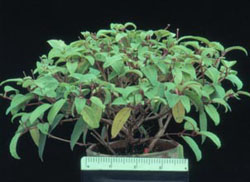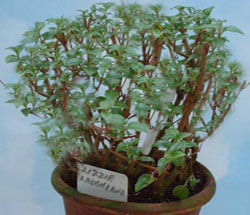This article was originally published on the web at fuchsiaclark.pwp.blueyonder.co.uk, however that website is defunct at December 2016. The copyright remains with the original author(s).
Fuchsia Pruning
This is a subject which is discussed most flippantly by both writers and speakers. I have both read and listened to advice on pruning and in nearly all cases it is just a reiteration of what has been written and handed down virtually from when fuchsias were first introduced. Few have troubled to observe, compare and test various methods to obtain the best results from over wintered plants.
The advice proffered when I was first introduced to fuchsia growing was, at the onset of winter, to prune hard back, ease off on watering and lay the pots on their side under the bench until early spring. This is a recipe for disaster. Losses through dehydration were extremely high especially during a hard winter. Things have now changed dramatically with almost every dedicated grower able to afford the luxury of at least a cool greenhouse or conservatory.
When, how and where to prune your fuchsias will now be explained in detail which, if followed, will result in fewer losses, virtually no misshapen plants through the uneven dehydration of mature ripe branches. It will also produce better and more even side shoots which will make excellent early short jointed cuttings. [See the article on Propagation.]
Towards the end of the growing season, which will be the end of September early October thought must be given to over wintering your stock plants, those needed for growing on the following season and those required for cutting material. There is a difference. The best for cutting material are the second year plants that have performed well all season and have maintained their shape and vigour. Select these carefully and only propagate from these plants. [See the article on Propagation] Each of your plants need to be pruned twice to obtain the best results.
The first pruning. Once these plants have been selected the first thing to do is to tie a label with their name on it firmly secured to one of the ripe branches. There is nothing more frustrating than losing a label and not being sure what plant is being propagated. Once this has been labeled correctly place each selected plant in turn on a bench and then gently prune. This term, gently prune, is best described as only pruning off the top part of each branch from a point where it first started to flower. If you examine each branch carefully you will see progressively from the tip down scars in the leaf axils where the flower pedicel, now aborted, was fixed to the branch. Continue down the branch until you reach the first pair of leaf axils with small or dormant buds, side shoots. Now prune off all the flowering branch about 2cm above these buds. This may sound a little exacting but in effect it is quite easy to quickly prune the rest of the plants to these standards once you understand what is required. The 9cm pot plant below is a visual example.

Continue this gentle pruning to the rest of your stock, removing all the old flowers and remaining seed pods and pedicels. Once finished these will be ready for the next stage which is delousing, eradicating all pests and diseases before potting down and housing for the winter.
See the article on 'Pests & Diseases'. Once this procedure of cleaning your stock is complete it will soon be time for the second and final pruning, the one that will ultimately allow you to start the new season with near perfect stock plants whether for pleasure or exhibition.
As the winter progresses through December into January the days will start to get longer with the light intensity and daytime temperatures increasing gradually. If you have followed the advice above your over wintering plants should now be showing signs of new growth. If the plants have been sprayed regularly then dehydration will have been dramatically reduced and tiny side shoots should now be appearing progressively up the branches as the sap starts to rise. Once this occurs and the tiny leaves start to open, it is time for the second and final pruning and shaping.

Some of your plants, especially those in the smaller pot sizes, 9cm to 12cm, will basically only need a slight trim and maybe a little wiring to obtain their final shape.
With the older larger plants you may need to be a little more severe to keep them within specific pot size limitations, especially if exhibiting where the framework is of paramount importance. The two plants below illustrate this technique. They are the same plant. The plant on the left is before pruning and the one on the right after pruning, were in addition, any weak and damaged branches have been removed.
 |
 |
After pruning your plants using this method, you may find the ends of the pruned branches will start to bleed. This is quite natural. The globule of sap leaking from the branch end will be attacked by a white fungus which will feed on the sap until the wound has healed. As the end of each pruned branch heals the fungus will die. It will not harm the plant in any way. Seeing the branch bleeding is a good indication that the branch is alive and it will now maintain its shape and produce some nice sturdy cuttings. If unsure whether any particular branch is dead just scratch the outer tissue, the epidermis, with your thumb nail. If the wood beneath is green it is still alive. If hard and dry it is dead and must be pruned back.
When pruning the plant to its final shape ensure that each branch has shoots appearing from the scar tissue of the aborted old leaves. This is also a good time to wire in any wayward branches and pull them back into the main framework.
Once the final pruning is complete it is still paramount to continue mist spraying to keep the ripened wood soft and subtle and within a very short period the side shoots will start to grow. At this point I must draw your attention to the selection of cutting material. You will recall I stressed the point about selecting your best plants to grow on for exhibiting, or take pride of place in your garden. I appreciate not everyone wants to exhibit their plants. Try not to spoil the shape of these plants by lopping off cuttings from here and there and everywhere. Take your cutting from your other selected stock plants that performed well the previous season. See the article on Propagation for more specific information.

As the season starts to warm up the new side shoots start to grow rapidly. Priorities now change and some thought must be given to stopping your plants in such a way that all the branches grow and flowers produced evenly over the whole plant, not just the odd branch here and there flowering without any uniformity. The next chapter will be an in depth study on the stopping and timing of your plants, whether for exhibiting, some special occasion, a blaze of colour in the garden, or in half baskets on a garage wall. It matters not, there will be something for everyone.

The end product, Dusky Beauty.


